
Abrytasites (Abrytusites) is an extinct genus of cephalopods belonging to the Ammonoidea subclass. The genus was named after the ancient Roman town of Abrittus, located near the present Bulgarian city of Razgrad. There are several described species of Abrytasites, including A. thieuloyi, A. julianyi, and A. neumayri. They are inflated, with constrictions, have rather thick ribs springing irregularly, singly or in pairs, from umbilical bullae. Their inner whorls closely resemble types species of Valdedorsella. This animal lived 125–136.4 million years ago during the Hauterivian and the Barremian in Europe and western Africa.
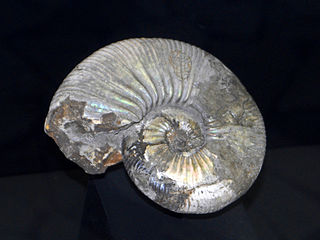
Acanthohoplites is an extinct genus of ammonites in the family Parahoplitidae that lived in the Aptian and Early Albian stages of the Early Cretaceous.

Australiceras is an extinct ammonite genus from the upper part of the Early Cretaceous, Aptian stage, included in the family Ancyloceratidae.

Nipponites is an extinct genus of heteromorph ammonites. The shells of Nipponites form "ox-bow" bends, resulting in some of the most bizarre shapes seen among ammonites.

Bostrychoceras is a genus of heteromorph ammonite from the family Nostoceratidae. Fossils have been found in Late Cretaceous sediments in Europe and North America.
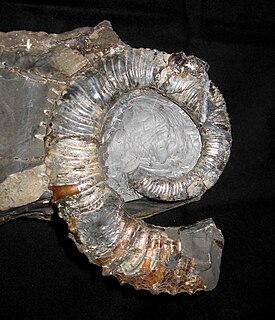
Exiteloceras is an ammonite genus from the Late Cretaceous.

Nostoceras is an extinct genus of ammonites. The etymology of the name Nostoceras comes from "nostos" meaning return and "ceros" meaning horn, named as such by Alpheus Hyatt because it bends back on itself.
Neoptychites is an extinct ammonoid cephalopod genus from the Turonian stage of the Upper Cretaceous, with a worldwide distribution.
Hypophylloceras is a Cretaceous ammonite with a finely ribbed, compressed, involute shell; some having periodic stronger ribs or folds. The suture is complex, with large, asymmetric and finely divided lobes; the 1st lateral being much larger than the external (=ventral) and 2nd lateral lobes. Saddle endings commonly not phylloid.

Calliphylloceras is an ammonite belonging to the Phylloceratidae.

Calycoceras is an extinct genus of cephalopods belonging to the subclass Ammonoidea and family Acanthoceratidae that lived during the Cenomanian stage of the Late Cretaceous, 100-94 Mya. Their shells had ornate ribs.

Barremitinae is a subfamily belonging to the Ammonoidea subclass. Whorl section in this group ranges from more or less circular through rectangular to oxyconic. Ribbing, if present, is weak. Suture is relatively simple, without markedly retracted suspensive lobe.

Hauericeras is an ammonite genus from the Late Cretaceous that lived from the Coniacian to the late Maastrichtian, from about 90 to 66 mya. Fossils have been found in Europe, Russia, South Africa, Australia, India, Iraq, and in the United States.
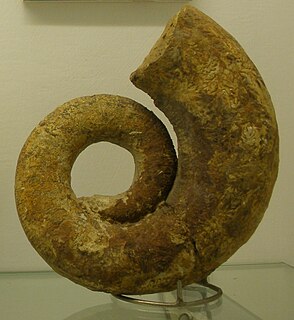
Lytoceras is an ammonite genus that was extant during most of the Jurassic and Cretaceous periods, and is the type genus for the family Lytoceratidae. These cephalopods were fast-moving nektonic carnivores.
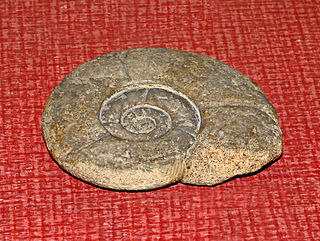
Puzosia is a genus of desmoceratid ammonites, and the type genus for the Puzosiinae, which lived during the middle part of the Cretaceous, from early Aptian to Maastrichtian. Sepkoski defines the range from Albian to Santonian. The generic name comes from the Serbian words "Puž" (snail) and "oce/ose" (axis), gaining its name from the shell's snail-like appearance.
Melchiorites is a desmoceratid ammonite genus included in the subfamily Puzosiinae. Member species are characterized by an essentially evolute shell in which the early whorls are smooth, with sinuous radial or oblique constrictions but in which later whorls have feeble intermediate ribs on the outer part of the sides and venter.

Pseudothurmannia is a genus of extinct cephalopods belonging to the subclass Ammonoidea and included in the family Crioceratitidae of the ammonitid superfamily Ancylocerataceae. These fast-moving nektonic carnivores lived in the Cretaceous period, from Hauterivian age to Barremian age.
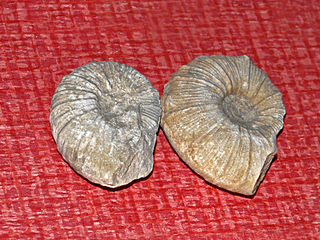
Holcodiscus is an extinct ammonite genus placed in the family Holcodiscidae. Species in this genus were fast-moving nektonic carnivores. The type species of the genus is Ammonites caillaudianus.

Kossmaticeras is an extinct ammonoid genus belonging to the desmoceratacean family Kossmaticeratidae. Species in this genus were fast-moving nektonic carnivores. They lived during the Late Cretaceous, from upper Turonian to upper Maastrichtian age. The type species of the genus is Ammonites theobaldianus.

Heinzia is an extinct ammonoid cephalopod genus belonging to the family Pulchelliidae. They lived during the Cretaceous, in the Barremian age.

















